2010临床试验2003版
临床试验伦理审查申请指南

临床试验伦理审查申请指南贵州医科大学第二附属医院临床试验伦理委员会临床试验伦理审查申请指南为指导研究者/申办者、课题负责人提交临床试验项目的伦理审查申请/报告,特制定本指南。
一、提交伦理审查的研究项目范围根据国家食品药品监督管理总局《药物临床试验质量管理规范》(2003年)、《药物临床试验伦理审查工作指导原则》(2010年)、《医疗器械临床试验质量管理规范》(2016版)、国家卫生和计划生育委员会《涉及人的生物医学研究伦理审查办法》(2016年)等相关法律法规,下列范围的研究项目应依据本指南提交伦理审查报告:·药物临床试验·医疗器械临床试验·涉及人的临床研究科研项目二、伦理审查申请/报告的类别1.初始审查初始审查申请:符合上述范围的临床试验项目,应在研究开始前提交伦理审查申请,经批准后方可实施。
“初始审查申请”是指首次向临床试验伦理委员会提交的审查申请。
2.跟踪审查1)修正案审查:研究过程中若变更主要研究者,对临床研究方案、知情同意书、招募材料等的任何修改,应向临床试验伦理委员会提交修正案审查申请,经批准后执行。
为避免研究对受试者的即刻危险,研究者可在临床试验伦理委员会批准前修改研究方案,事后应将修改研究方案的情况及原因,以“修正案审查申请”的方式及时提交临床试验伦理委员会审查。
2)研究进展报告:按照伦理审查批件,意见规定的年度,定期跟踪审查频率,在截止日期前1个月提交研究进展报告;申办者应当向组长单位伦理委员会提交各中心研究进展的汇总报告;当出现任何可能显著影响研究进行或增加受试者危险的情况时,应以“研究进展报告”的方式,及时报临床试验伦理委员会审查。
如果伦理审查批件有效期到期,而项目没有启动,需重新提交伦理申请并获得批准后方可实施。
3)严重不良事件报告:严重不良事件是指临床研究过程中发生需住院治疗、延长住院时间、伤残、影响工作能力、危及生命或死亡、导致先天畸形等事件。
国家食品药品监督管理局关于印发药物临床试验伦理审查工作指导原则的通知

国家食品药品监督管理局关于印发药物临床试验伦理审查工作指导原则的通知文章属性•【制定机关】国家食品药品监督管理局(已撤销)•【公布日期】2010.11.02•【文号】国食药监注[2010]436号•【施行日期】2010.11.02•【效力等级】部门规范性文件•【时效性】现行有效•【主题分类】药政管理正文国家食品药品监督管理局关于印发药物临床试验伦理审查工作指导原则的通知(国食药监注[2010]436号)各省、自治区、直辖市食品药品监督管理局(药品监督管理局),总后卫生部药品监督管理局:为加强药物临床试验的质量管理和受试者的保护,规范和指导伦理委员会的药物临床试验伦理审查工作,提高药物临床试验伦理审查工作质量,根据《药品注册管理办法》和《药物临床试验质量管理规范》的有关规定,国家局组织制定了《药物临床试验伦理审查工作指导原则》,现予印发。
请你局指导本辖区内药物临床试验机构学习,参照执行。
附件:药物临床试验伦理审查工作指导原则起草说明国家食品药品监督管理局二○一○年十一月二日附件:《药物临床试验伦理审查工作指导原则》起草说明为了加强对伦理委员会药物临床试验伦理审查工作的指导,规范伦理委员会的药物临床试验伦理审查工作,切实保护受试者的安全和权益。
国家局组织制定了《药物临床试验伦理审查工作指导原则》(以下简称《指导原则》),旨在促进国内药物临床试验伦理审查能力的提高,充分发挥伦理委员会在保护受试者安全和权益中的作用,进一步规范药物临床试验的研究行为。
一、背景和必要性药物临床试验应遵循两大基本原则--研究的科学性和伦理的合理性。
伦理委员会审查是保护受试者的安全与权益、保证药物临床试验伦理合理性的重要措施之一,在药物临床研究中发挥重要作用。
针对涉及人体的生物医学研究和临床试验,世界各国发布了伦理指南与法规性文件。
美国专门针对生物医学研究受试者保护颁布了联邦法规文件,其中21CFR56阐述伦理委员会审查,并在美国健康与人类事业部专门成立了人体受试者保护办公室;欧洲2005年新颁布的临床研究指令相对以往法规重要的变更之一,是临床研究需要同时获得药政管理部门和伦理委员会的批准方可进行研究;新加坡1997年出台涉及人体受试者研究的伦理指南。
医学伦理委员会文件保密制度
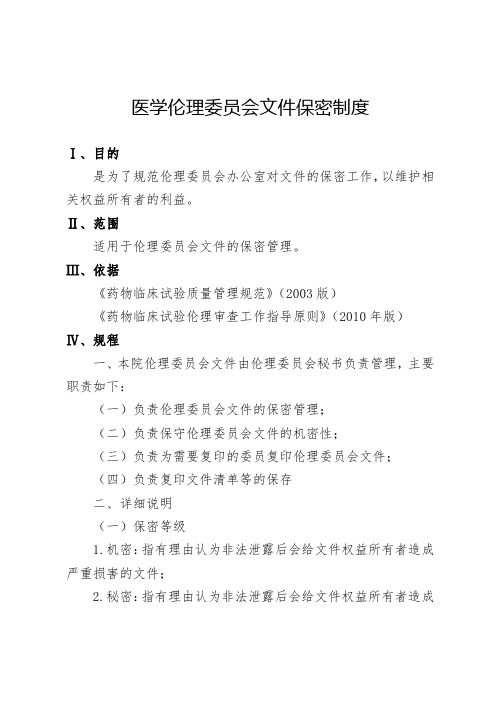
医学伦理委员会文件保密制度Ⅰ、目的是为了规范伦理委员会办公室对文件的保密工作,以维护相关权益所有者的利益。
Ⅱ、范围适用于伦理委员会文件的保密管理。
Ⅲ、依据《药物临床试验质量管理规范》(2003版)《药物临床试验伦理审查工作指导原则》(2010年版)Ⅳ、规程一、本院伦理委员会文件由伦理委员会秘书负责管理,主要职责如下:(一)负责伦理委员会文件的保密管理;(二)负责保守伦理委员会文件的机密性;(三)负责为需要复印的委员复印伦理委员会文件;(四)负责复印文件清单等的保存二、详细说明(一)保密等级1.机密:指有理由认为非法泄露后会给文件权益所有者造成严重损害的文件;2.秘密:指有理由认为非法泄露后会给文件权益所有者造成损害的文件;3.内部文件:指不宜公开的文件;4.文件类别与保密等级见附件。
(二)保密期限与解密1.机密类文件保密期限为研究项目完成后5年,期满后保密等级降级还需要得到研究项目申办者的授权;2.秘密类文件保密期限为5年,期满后保密等级降为内部文件。
;(三)访问权限1.访问机密类文件,需要填写文件/资料借阅/复印申请表,经过审核批准,并签署保密协议;2.访问秘密类文件,需要经过秘书同意,必要时签署保密协议;3.访问内部文件,需要经过秘书同意。
(四)日常管理1.资料档案室大门钥匙有秘书和资料档案室工作人员保管,伦理委员会的文件钥匙由2人(伦理主任委员及伦理秘书)保管;2.获得批准查阅或复印文件:✓进入资料室须由专人陪同;✓由管理人员调取文件,在指定的地点阅读,复印由秘书代办;✓秘书填写“文件/资料借阅、复印登记表;(五)处罚1.工作人员违反本规定,给予批评;后果严重造成损失者,应承担相应的法律后果;2.其他人员违反本规定,擅自进入资料档案室,查阅文件,责令立即纠正;3.违反保密协议者,承担相应的法律责任。
医学伦理委员会组成及任命的标准操作规程
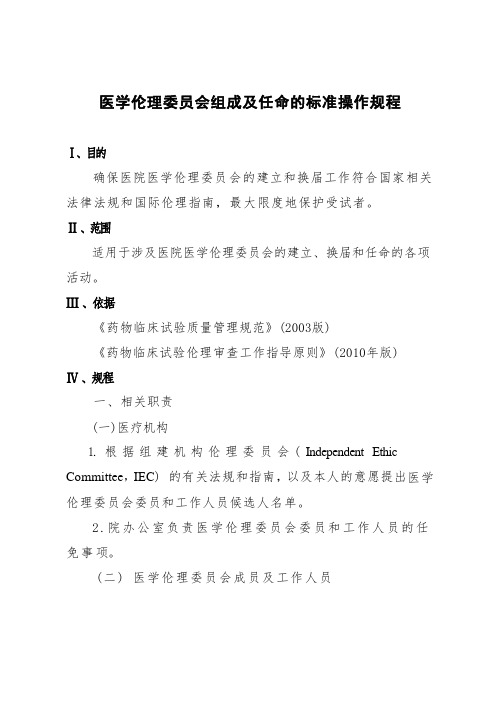
医学伦理委员会组成及任命的标准操作规程确保医院医学伦理委员会的建立和换届工作符合国家相关法律法规和国际伦理指南,最大限度地保护受试者。
适用于涉及医院医学伦理委员会的建立、换届和任命的各项活动。
《药物临床试验质量管理规范》(2003版)《药物临床试验伦理审查工作指导原则》(2010年版)一、相关职责(一)医疗机构1. 根据组建机构伦理委员会 ( Independent Ethic Committee,IEC) 的有关法规和指南,以及本人的意愿提出医学伦理委员会委员和工作人员候选人名单。
2.院办公室负责医学伦理委员会委员和工作人员的任免事项。
(二) 医学伦理委员会成员及工作人员有责任阅读、熟悉和遵照执行本机构医学伦理委员会制定的各项规定。
二、详细说明(一) 明确组建依据法规和指南:WHO 生物医学研究审查医学伦理委员会操作指南和我国《药物临床试验质量管理规范》(2003) 、《药物临床试验伦理审查工作指导原则》(2010 年版) 、《医疗器械临床试验规定》(2004)。
(二) 隶属关系:本医学伦理委员会隶属于xx医院。
医学伦理委员会的文件在国家食品药品监督管理总局和卫生健康行政主管部门备案。
(三) 确定医学伦理委员会的职责1.医学伦理委员会的审查范围:本医学伦理委员会负责对本院所承担实施的涉及人体的生物医学研究项目进行审查。
医学伦理委员会审查的主要类别包括但不限于药物临床试验;2.审查职责:所有涉及人体受试者的研究方案或相关文件都必须在研究开始以前提交医学伦理委员会审查,并获得批准;3.医学伦理委员会审查研究项目时应履行基本职责:独立的和及时的;科学审查和伦理审查;初次审查和跟踪审查。
(四) 认定委员资格1.委员应包括医学专业人员 (具有副高以上技术职称的医学、药学和护理专业人员);非医学专业人员(代表社区利益(公众利益)的人员);法律专家;外单位人员;2.医学伦理委员会至少 5 人,应有不同年龄层次和不同性别的委员;3.医学伦理委员会委员可以是兼职的。
consort2010版准则的主要内容
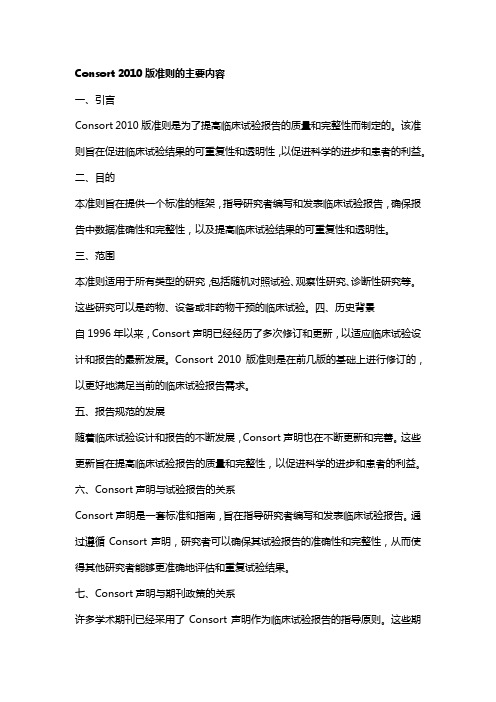
Consort 2010版准则的主要内容一、引言Consort 2010版准则是为了提高临床试验报告的质量和完整性而制定的。
该准则旨在促进临床试验结果的可重复性和透明性,以促进科学的进步和患者的利益。
二、目的本准则旨在提供一个标准的框架,指导研究者编写和发表临床试验报告,确保报告中数据准确性和完整性,以及提高临床试验结果的可重复性和透明性。
三、范围本准则适用于所有类型的研究,包括随机对照试验、观察性研究、诊断性研究等。
这些研究可以是药物、设备或非药物干预的临床试验。
四、历史背景自1996年以来,Consort声明已经经历了多次修订和更新,以适应临床试验设计和报告的最新发展。
Consort 2010版准则是在前几版的基础上进行修订的,以更好地满足当前的临床试验报告需求。
五、报告规范的发展随着临床试验设计和报告的不断发展,Consort声明也在不断更新和完善。
这些更新旨在提高临床试验报告的质量和完整性,以促进科学的进步和患者的利益。
六、Consort声明与试验报告的关系Consort声明是一套标准和指南,旨在指导研究者编写和发表临床试验报告。
通过遵循Consort声明,研究者可以确保其试验报告的准确性和完整性,从而使得其他研究者能够更准确地评估和重复试验结果。
七、Consort声明与期刊政策的关系许多学术期刊已经采用了Consort声明作为临床试验报告的指导原则。
这些期刊要求作者在提交临床试验报告时遵循Consort声明的标准。
通过遵循这些标准,作者可以确保其论文的质量和完整性,从而增加被期刊接受的机会。
八、核查单与流程图为了帮助研究者遵循Consort声明,许多组织已经开发了核查单和流程图。
这些工具可以帮助研究者确保其试验报告的准确性和完整性,并提高报告的可重复性和透明性。
研究者可以使用这些工具来核查其报告是否符合Consort声明的标准。
九、核查单的应用核查单是一种重要的工具,可以帮助研究者检查其试验报告是否符合Consort 声明的标准。
药物Ⅰ期临床试验管理指导原则
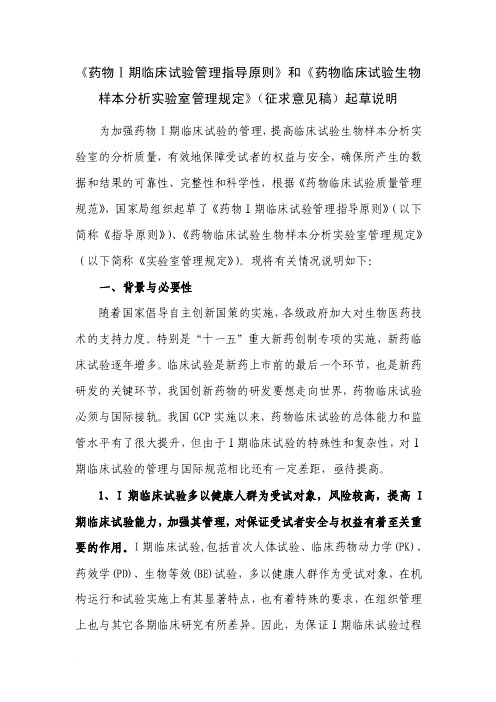
《药物Ⅰ期临床试验管理指导原则》和《药物临床试验生物样本分析实验室管理规定》(征求意见稿)起草说明为加强药物I期临床试验的管理,提高临床试验生物样本分析实验室的分析质量,有效地保障受试者的权益与安全,确保所产生的数据和结果的可靠性、完整性和科学性,根据《药物临床试验质量管理规范》,国家局组织起草了《药物Ⅰ期临床试验管理指导原则》(以下简称《指导原则》)、《药物临床试验生物样本分析实验室管理规定》(以下简称《实验室管理规定》)。
现将有关情况说明如下:一、背景与必要性随着国家倡导自主创新国策的实施,各级政府加大对生物医药技术的支持力度。
特别是“十一五”重大新药创制专项的实施,新药临床试验逐年增多。
临床试验是新药上市前的最后一个环节,也是新药研发的关键环节,我国创新药物的研发要想走向世界,药物临床试验必须与国际接轨。
我国GCP实施以来,药物临床试验的总体能力和监管水平有了很大提升,但由于Ⅰ期临床试验的特殊性和复杂性,对Ⅰ期临床试验的管理与国际规范相比还有一定差距,亟待提高。
1、I期临床试验多以健康人群为受试对象,风险较高,提高I 期临床试验能力,加强其管理,对保证受试者安全与权益有着至关重要的作用。
I期临床试验,包括首次人体试验、临床药物动力学(PK)、药效学(PD)、生物等效(BE)试验,多以健康人群作为受试对象,在机构运行和试验实施上有其显著特点,也有着特殊的要求,在组织管理上也与其它各期临床研究有所差异。
因此,为保证Ⅰ期临床试验过程规范,结果科学可靠,保护受试者的安全与权益,亟需规范Ⅰ期临床试验过程管理,提高临床试验能力和水平。
2、随着国家鼓励自主创新政策的实施和跨国公司新药研发向我国的转移,我国创新药物的申报量逐年增加,对我国Ⅰ期临床试验的总体能力和监管体系带来挑战。
据统计,2008年我国批准的新药临床、国际多中心临床试验分别是581个、40个, 2009年分别增长到1105个、132个。
临床试验的逐年增多,尤其是新药临床试验的增长,对我国Ⅰ期临床试验的总体能力和监管体系提出挑战。
临床研究填写指南
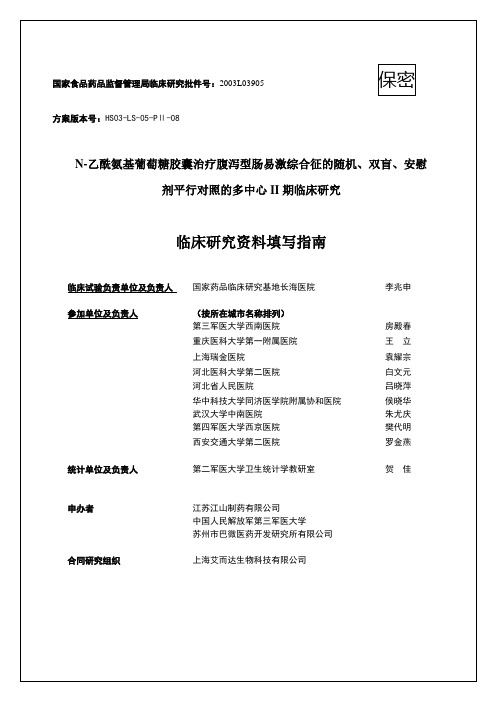
开始时间 结束时间 目前持续 (年/月/日) (年/月/日) (请划“×” ) UN 22004/1/10 2004/4/15 × □
如 果受试者 所患疾病 目 □ 前仍未治愈,则“结束时 □ 间”可以不填,并在后面 的空格中选择目前持续 □ □ □ □
第5页
N-乙酰氨基葡萄糖 II 期临床试验临床研究资料填写指南 N-乙酰氨基葡萄糖 II 期临床试验病例报告表 申办者: 江苏江山制药有限公司
×无 ×否 是 病程:1 0月
如果是女性,则生育次数是1次 ,是否已经绝经 身高 1 7 5cm
体重0 6 5.5kg
生命体征 体温 血压 3 6.5摄氏度 1 1 0/0 8 5mmHg 呼吸速率 静息心率 1 5次/分 0 6 5次/分
体格检查 系统 耳、鼻、喉 、眼 呼吸系统 消化系统 泌尿系统 中枢神经系统 血液及淋巴系统 内分泌系统 皮肤 其他 × × × × × × × 请研究者在此签 字 □ 此处填写研究者签 字的日期 日期:____________________ 如果体检时发现异常请 在画横线处详细描述 正常 × × 左下肺湿罗音 异常 如果异常请说明
合同研究组织: 合同研究组织: 上海艾而达生物科技有限公司
第3页
N-乙酰氨基葡萄糖 II 期临床试验临床研究资料填写指南 N-乙酰氨基葡萄糖 II 期临床试验病例报告表 申办者:江苏江山制药有限公司
批准文号 2003L03905
试验中心 0
药物编号 0 1 8
受试者姓名缩写 W X W E
就诊日期 2004年1 1月0 8日
N-乙酰氨基葡萄糖 II 期临床试验临床研究资料填写指南
I.
总则
1、 2、 所有的临床研究资料应使用黑色水笔及时填写。 填写务必准确,字迹应清晰可辨,不得随意涂改,错误之处纠正时需用横线居中划出,并在错 误处右上方签署修改者姓名或姓名缩写及修改时间,原改处内容应能清晰可见,修改后的内容 填写在原内容上方。 36.4 举例:: 57.6 3、
盲法、安慰剂和伦理问题 2003年研究生临床试验课知识分享

2020/5/22
2003研究生临床试验课
17
药物编盲
由不参与临床试验的人员根据已产生的 随机数对试验用药物进行分配编码的过 程称为药物编盲,
2020/5/22
2003研究生临床试验课
18
药物的编码及分配
在双盲试验中需特别小心!!!
一个失败的例子
(一种干扰素治疗肝炎) 解决办法: 试验药和对照药分开进行随机
一般不知道的还有评定者、监查员、数 据管理员和统计分析者等。
其优点是对疗效和不良反应的评定更为 客观。使试验更为科学。
2020/5/22
2003研究生临床试验课
8
双盲试验的困难
由于伦理问题不能进行双盲:
链霉素治疗肺结核。不能对对照进
行许多次注射。
不可行:
手术与保守疗法的比较。手术组可以
用安慰剂,对照组不能开一刀。
肿瘤化疗需要经常调节剂量。
2020/5/22
2003研究生临床试验课
9
药物反应影响双盲
药物反应对双盲有时有影响: 塞尼可最常见的不良反应是胃肠道反应,
多为油性斑点及油性大便,这也是塞尼 可在胃肠道抑制脂肪的吸收,发挥其药 物作用的表现。
2020/5/22
2003研究生临床试验课
2020/5/22
2003研究生临床试验课
36
试验是否需要征得病人的同意
赫尔辛基宣言: 医师应当得到研究对象自愿地申明同意,
最好是书面的。 如果医师认为有必要不征求病人同意,
则在试验方案中应当写明其理由。
2020/5/22
2003研究生临床试验课
37
试验是否需要征得病人的同意
美国:法律规定必须取得病人的书面同
新版GCP实施后药物临床试验现场核查的关注点及常见问题浅析
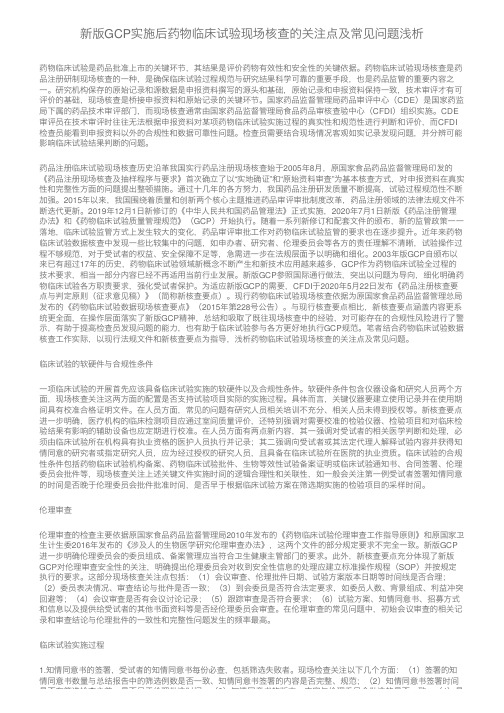
新版GCP实施后药物临床试验现场核查的关注点及常见问题浅析药物临床试验是药品批准上市的关键环节,其结果是评价药物有效性和安全性的关键依据。
药物临床试验现场核查是药品注册研制现场核查的⼀种,是确保临床试验过程规范与研究结果科学可靠的重要⼿段,也是药品监管的重要内容之⼀。
研究机构保存的原始记录和源数据是申报资料撰写的源头和基础,原始记录和申报资料保持⼀致,技术审评才有可评价的基础,现场核查是桥接申报资料和原始记录的关键环节。
国家药品监督管理局药品审评中⼼(CDE)是国家药监局下属的药品技术审评部门,⽽现场核查通常由国家药品监督管理局⾷品药品审核查验中⼼(CFDI)组织实施。
CDE 审评员在技术审评时往往⽆法根据申报资料对某项药物临床试验实施过程的真实性和规范性进⾏判断和评价,⽽CFDI 检查员能看到申报资料以外的合规性和数据可靠性问题。
检查员需要结合现场情况客观如实记录发现问题,并分辨可能影响临床试验结果判断的问题。
药品注册临床试验现场核查历史沿⾰我国实⾏药品注册现场核查始于2005年8⽉,原国家⾷品药品监督管理局印发的《药品注册现场核查及抽样程序与要求》⾸次确⽴了以“实地确证”和“原始资料审查”为基本核查⽅式,对申报资料在真实性和完整性⽅⾯的问题提出整顿措施。
通过⼗⼏年的各⽅努⼒,我国药品注册研发质量不断提⾼,试验过程规范性不断加强。
2015年以来,我国围绕着质量和创新两个核⼼主题推进药品审评审批制度改⾰,药品注册领域的法律法规⽂件不断迭代更新。
2019年12⽉1⽇新修订的《中华⼈民共和国药品管理法》正式实施,2020年7⽉1⽇新版《药品注册管理办法》和《药物临床试验质量管理规范》(GCP)开始执⾏。
随着⼀系列新修订和配套⽂件的颁布,新的监管政策⼀⼀落地,临床试验监管⽅式上发⽣较⼤的变化,药品审评审批⼯作对药物临床试验监管的要求也在逐步提升。
近年来药物临床试验数据核查中发现⼀些⽐较集中的问题,如申办者、研究者、伦理委员会等各⽅的责任理解不清晰,试验操作过程不够规范,对于受试者的权益、安全保障不⾜等,急需进⼀步在法规层⾯予以明确和细化。
医学伦理委员会工作制度
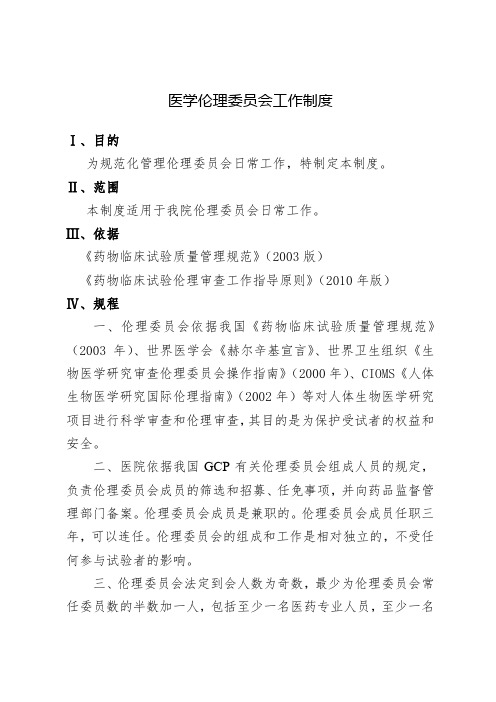
医学伦理委员会工作制度Ⅰ、目的为规范化管理伦理委员会日常工作,特制定本制度。
Ⅱ、范围本制度适用于我院伦理委员会日常工作。
Ⅲ、依据《药物临床试验质量管理规范》(2003版)《药物临床试验伦理审查工作指导原则》(2010年版)Ⅳ、规程一、伦理委员会依据我国《药物临床试验质量管理规范》(2003年)、世界医学会《赫尔辛基宣言》、世界卫生组织《生物医学研究审查伦理委员会操作指南》(2000年)、CIOMS《人体生物医学研究国际伦理指南》(2002年)等对人体生物医学研究项目进行科学审查和伦理审查,其目的是为保护受试者的权益和安全。
二、医院依据我国GCP有关伦理委员会组成人员的规定,负责伦理委员会成员的筛选和招募、任免事项,并向药品监督管理部门备案。
伦理委员会成员是兼职的。
伦理委员会成员任职三年,可以连任。
伦理委员会的组成和工作是相对独立的,不受任何参与试验者的影响。
三、伦理委员会法定到会人数为奇数,最少为伦理委员会常任委员数的半数加一人,包括至少一名医药专业人员,至少一名非医药专业人员,至少一名外单位的人员。
只有参与审查的伦理委员会成员才有决定权。
以投票方式做出决定。
四、伦理委员会成员都必须接受有关生物医学研究的伦理道德和科学方面的初始培训和继续教育,并通过考核合格表明其达到培训的要求和预期目标。
五、伦理委员会成员应签署委员声明,同意公开他/她的完整姓名、职业和隶属关系;同意应要求公开其工作报酬和其他有关开支。
六、伦理委员会成员应签署一项有关会议审议内容、申请材料、受试者信息和相关事宜的保密承诺。
七、每次伦理审查前,伦理委员会成员或聘请的独立顾问均应声明是否存在与伦理审查有关的利益冲突,保证将任何可能有关的利益冲突向伦理委员会报告。
八、伦理委员会设秘书1人,负责受理伦理审查申请材料、会议日程安排、会议记录、决议通告、档案管理、年度工作总结以及经费管理等工作。
药物临床试验质量管理规范Good Clinical Practice,GCP

伦理委员会
工作规则
审阅每年至少一次,或视临床试验项目而定 多数委员出席方有效,出席委员投票 试验方案需经伦理委员会批准后方可实施 委员回避制度 邀请出席的专家不投票 会议有书面记录,记录保存5年 决议书面通知研究者、申办者
国际上GCP的发展过程
1961 1962 1980 1986
1987 1989
1991 1993
沙利度胺(反应停Thalidomide)事件 美国药品修正法案 美国联邦法典 欧洲共同体GCP 英国GCP 法国GCP 北欧GCP 日本GCP 加拿大GCP 澳大利亚GCP
WHO GCP
国际协调会议(美、欧、日) International Conference of Harmonization (ICH)
试验方案
受试者的入选标准,排除标准和剔除标准,选择受 试者的步骤,受试者分配的方法
根据统计学原理计算要达到试验预期目的所需的病 例数
试验用药品的剂型、剂量、给药途径、给药方法、 给药次数、疗程和有关合并用药的规定,以及对包 装和标签的说明
拟进行临床和实验室检查的项目、测定的次数和药 代动力学分析等
知情同意书
提供资料 试验的性质和过程 药品的特点 可能的受益和不良反应 过去的经验 受损的补偿 退出的权利 资料的保密
面谈 本人签字,儿童或无行为能力者由法定监护人签字 语言及文学表达受试者能懂
试验方案
试验题目 试验目的,试验背景,临床前研究中有临床意义的
发现和与该试验有关的临床试验结果、已知对人体 的可能危险与受益,及试验药物存在人种差异的可 能 申办者的名称和地址,进行试验的场所,研究者的 姓名、资格和地址 试验设计的类型,随机化分组方法及设盲的水平
药物临床试验质量管理规范(2003年版)

药物临床试验质量管理规范(2003年版)国家食品药品监督管理局令(第3号)二○○三年八月六日第一章总则第一条为保证药物临床试验过程规范,结果科学可靠,保护受试者的权益并保障其安全,根据《中华人民共和国药品管理法》、《中华人民共和国药品管理法实施条例》,参照国际公认原则,制定本规范。
第二条药物临床试验质量管理规范是临床试验全过程的标准规定,包括方案设计、组织实施、监查、稽查、记录、分析总结和报告。
第三条凡进行各期临床试验、人体生物利用度或生物等效性试验,均须按本规范执行。
第四条所有以人为对象的研究必须符合《世界医学大会赫尔辛基宣言》(附录1),即公正、尊重人格、力求使受试者最大程度受益和尽可能避免伤害。
第二章临床试验前的准备与必要条件第五条进行药物临床试验必须有充分的科学依据。
在进行人体试验前,必须周密考虑该试验的目的及要解决的问题,应权衡对受试者和公众健康预期的受益及风险,预期的受益应超过可能出现的损害。
选择临床试验方法必须符合科学和伦理要求。
第六条临床试验用药品由申办者准备和提供。
进行临床试验前,申办者必须提供试验药物的临床前研究资料,包括处方组成、制造工艺和质量检验结果。
所提供的临床前资料必须符合进行相应各期临床试验的要求,同时还应提供试验药物已完成和其它地区正在进行与临床试验有关的有效性和安全性资料。
临床试验药物的制备,应当符合《药品生产质量管理规范》。
第七条药物临床试验机构的设施与条件应满足安全有效地进行临床试验的需要。
所有研究者都应具备承担该项临床试验的专业特长、资格和能力,并经过培训。
临床试验开始前,研究者和申办者应就试验方案、试验的监查、稽查和标准操作规程以及试验中的职责分工等达成书面协议。
第三章受试者的权益保障第八条在药物临床试验的过程中,必须对受试者的个人权益给予充分的保障,并确保试验的科学性和可靠性。
受试者的权益、安全和健康必须高于对科学和社会利益的考虑。
伦理委员会与知情同意书是保障受试者权益的主要措施。
GCP(中国)2003版
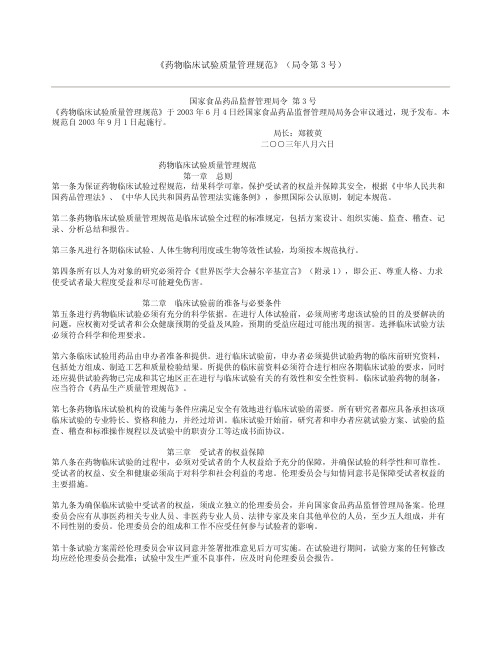
�号 3 第令局�》范规理管量质验试床并定商同共者办申与者究研由应案方该�案方验试定制应前始开验试床临条六十第 案方验试 章四第 。意同者 试受得取次再�后准批会员委理伦送改修面书作书意同情知将须必则料资新要重的物药验试及涉现发如�五� �意同会员委理伦得取先事并�法方的者试受些这受 接明说楚清中件文关有和案方验试在要需但�者试受为作虑考可�痛病轻减或�康健复恢�命生救挽望有物药 验试而�法方疗治的效有实证被已乏缺如�书意同情知的人表代法合其及人本得取法无�下况情急紧在�四� �意同人本其得征须必还�时定决 的究研加参意同出做能童儿当�书意同情知署签并意同情知的人护监定法其得征须必�者试受为作童儿�三� �期日明注及名签并意同人护监定法其经应时同�验试入进以可也人病些这则 �时益利身本其合符验试加参者试受为认者究研、意同上则原会员委理伦果如�者试受的力能为行无对�二� �期日和名姓署签上书 意同情知在需也者究研的程过意同情知行执�期日明注并字签上书意同情知在人理代定法其或者试受由�一� �书意同情知得获后况情的验试释解细详和分充经条五十第 。偿补的应相和疗治得获以可者试受�时害损的关相验试与生发如�五� �料资息信的关有其与解了时 随可者试受�间期验试�字文和言语的解理能人理代定法或者试受用采应程过意同情知。明说与绍介述上供提 人理代定法其向应�者试受的意同达表力能无对�验试加参意愿否是虑考便以间时的分充者试受给须必�四� �别组同不的验 试到配分被能可者试受知告�险风和益受的能可期预者试受、作操查检、限期与程过的验试、的目验试�三� �料资者试受的验试加参阅查以可定规按�者办申或会 员委理伦、门部理管督监品药�时要必。密保属均料资人个的中验试在及验试加参�解了者试受使须必�二� �响影到受会不益权与遇待 疗医其�复报或视歧到遭会不而验试出退时随段阶何任的验试在权有且而�的愿自是应验试加参者试受�一� �况情细详的验试床临关有明说者试受向须必表代的定指其或者究研条四十第 。验试的准批已停暂或止终�四� �意同不�三� �意同后正修的要必作�二� �意同�一� �是以可见意的会员委理伦。名签人本及况情 业专、单名员委的议会席出附并�见意面书发签�论讨阅审�议会开召时及应后请申到接会员委理伦条三十第 。度程险风的者试受中行进验试床临查审期定�6� �受接可否是见意正修的出提案方验试对�5� �施措险保或/和疗治的予给�时亡死生发至甚害损到受而验试床临加参因者试受�4� �当适否是法方的书意同情知取获�懂 易整完否是料资息信的验试本关有供提�人理代定法、人护监、属家其或�者试受向�法方的选入者试受�3� �性学科的 计设验试及益受和险风的受遭能可员人他其及者试受、的目究研括包�则原理伦了虑考分充否是案方验试�2� �求要验试合符否是等件条备设及备配员人�验试床临加参间时的分充有否是、验经、格资的者究研�1� �案方验试议审项各列下按格严度角的益权者试受障保从应会员委理伦条二十第 。年五后束结验试床临至存保录记�录记面书有应均 议决其及议会有所�序程作工立建应会员委理伦。票投不但�议会席出家专的员委非请邀可要需作工因。避回 当应员委的验试床临该与参�定决出作式方票投以后论讨在应见意查审的案方验试床临对会员委理伦条一十第
药物临床试验的伦理审查

II期、III期临床试验:目标适应症人群; 注意疾病的严重程度
受试者排除标准 排除更易受伤害的受试者 排除易混淆试验结果的受试者
受试者的选择-2
个体受试者退出标准
随时自愿退出 发生临床显著意义的事件 疾病恶化
试验中止标准
潜在风险大于可能的获益 已得到有利结果的确切证据
信息,或者试验的步骤有修改,均应对知情同意书进
行修改,以确保所有受试者应该了解的信息都包含在
修改后的知情同意书中。 修改后的知情同意书必须递交伦理委员会批准后方可 使用。
新版知情同意书,受试者是否需要再签署?
凡是在伦理委员会批准之后入选的受试者均应签署修 改后的知情同意书。
在伦理委员会批准之前已签署知情同意书,且目前仍 在试验中的受试者,应再签署修改后的知情同意书, 该知情同意书应与最初签署的知情同意书共同保存。 对于已经完成临床试验或已经从临床试验中退出的 受试者,一般无需再签署修改后的知情同意书。
《药物临床试验质量管理规范》
( SFDA 2003年8月6日 发布 )
第十条 试验方案需经伦理委员会审议同 意并签署批准意见后方可实施。在试验进 行期间,试验方案的任何修改均应经伦理 委员会批准;试验中发生严重不良事件, 应及时向伦理委员会报告。
对临床试验的跟踪审查
跟踪审查的内容:
修正案审查
四. 伦理审查流程
伦理委员会审查哪些文件?
怎么审?
对临床试验的初始审查
提交初始审查的文件一般包括:
伦理审查申请表 SFDA的药物临床试验批件 试验方案(版本号和日期) 知情同意书(版本号和日期) 研究者手册(版本号和日期) 招募受试者的相关材料 病例报告表 主要研究者简历 其他伦理委员会的审查决定
药物临床试验质量管理规范Good Clinical Practice,GCP

申办者(sponsor)的职责(3)
建立质量控制与质量保证系统-按方案、法规与GCP 要求进行试验数据产生、登录与报告正确、所有试验 场所、数据、文件、报告均应供稽查
任命监查员(monitor)并为研究者接受 与研究者一起迅速研究严重不良事件,采取措施,向
药政部门报告,向其他研究者通报 向药政主管部门递交试验总结报告,或中止试验报告
GCP的适用范围
是临床试验全过程的标准、规定。 方案设计、组织实施、监查、稽查、记录、分 析总结和报告
适用于:各期临床试验、人体生物利用度或生 物等效性试验
试验前准备
科学依据 周密考虑该试验治疗效果和可能产生的危害, 预期的受益应超过可能出现的危害 选择临床实验方法必须符合科学和伦理要求 有充分的临床前和临床资料 试验方案应具有详细的规定和描写
数据管理与统计分析
保证数据输入和处理的整个过程中数据完整 制订数据处理和统计分析的标准操作规程 保证研究过程的设盲状态(病人,申办者,研究员),
规定揭盲和破盲条件和方法
数据管理与统计分析
电子数据管理系统的建立 有特定的标准操作规程 容许输入后改正,改正(何时何人)应在电子数据 档案中写明 系统保持保密和保安 备份 电脑系统确认
试验方案
受试者的入选标准,排除标准和剔除标准,选择受 试者的步骤,受试者分配的方法
根据统计学原理计算要达到试验预期目的所需的病 例数
试验用药品的剂型、剂量、给药途径、给药方法、 给药次数、疗程和有关合并用药的规定,以及对包 装和标签的说明
拟进行临床和实验室检查的项目、测定的次数和药 代动力学分析等
根据《中华人民共和国药品管理法》、《中华 人民共和国药品管理法实施条例》
参照国际公认原则 《世界医学大会赫尔辛基宣言》:即公正、 尊重人格、力求使受试者最大程度受益和尽 可能避免伤害
SDA_2003_GCP 药物临床试验质量管理规范英文版
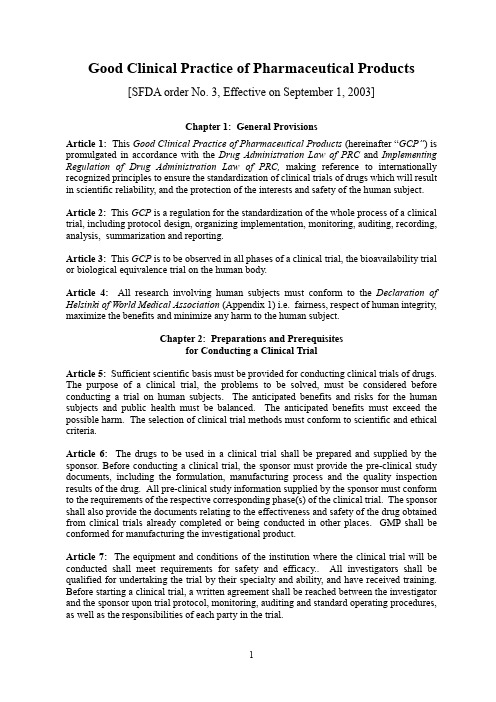
Good Clinical Practice of Pharmaceutical Products [SFDA order No. 3, Effective on September 1, 2003]Chapter 1: General ProvisionsArticle 1: This Good Clinical Practice of Pharmaceutical Products (hereinafter “GCP”) is promulgated in accordance with the Drug Administration Law of PRC and Implementing Regulation of Drug Administration Law of PRC, making reference to internationally recognized principles to ensure the standardization of clinical trials of drugs which will result in scientific reliability, and the protection of the interests and safety of the human subject. Article 2: This GCP is a regulation for the standardization of the whole process of a clinical trial, including protocol design, organizing implementation, monitoring, auditing, recording, analysis, summarization and reporting.Article 3: This GCP is to be observed in all phases of a clinical trial, the bioavailability trial or biological equivalence trial on the human body.Article 4:All research involving human subjects must conform to the Declaration of Helsinki of World Medical Association (Appendix 1) i.e. fairness, respect of human integrity, maximize the benefits and minimize any harm to the human subject.Chapter 2: Preparations and Prerequisitesfor Conducting a Clinical TrialArticle 5: Sufficient scientific basis must be provided for conducting clinical trials of drugs. The purpose of a clinical trial, the problems to be solved, must be considered before conducting a trial on human subjects. The anticipated benefits and risks for the human subjects and public health must be balanced. The anticipated benefits must exceed the possible harm. The selection of clinical trial methods must conform to scientific and ethical criteria.Article 6:The drugs to be used in a clinical trial shall be prepared and supplied by the sponsor. Before conducting a clinical trial, the sponsor must provide the pre-clinical study documents, including the formulation, manufacturing process and the quality inspection results of the drug. All pre-clinical study information supplied by the sponsor must conform to the requirements of the respective corresponding phase(s) of the clinical trial. The sponsor shall also provide the documents relating to the effectiveness and safety of the drug obtained from clinical trials already completed or being conducted in other places. GMP shall be conformed for manufacturing the investigational product.Article 7: The equipment and conditions of the institution where the clinical trial will be conducted shall meet requirements for safety and efficacy.. All investigators shall be qualified for undertaking the trial by their specialty and ability, and have received training. Before starting a clinical trial, a written agreement shall be reached between the investigator and the sponsor upon trial protocol, monitoring, auditing and standard operating procedures, as well as the responsibilities of each party in the trial.Chapter 3: Protection of a Human Subject’s InterestsArticle 8: In a drug clinical trial, the human subject’s interests must be fully protected and the trial shall be scientific and reliable. The human subject’s interests, safety and health must be higher than the consideration for science and social interests. The use of an Ethics Committee and informed consent form are important methods to protect the human subject.Article 9:In order to protect the interests of human subjects, an independent Ethics Committee shall be formed and such information filed with SFDA. The Ethics Committee shall consist of at least five people of different genders including those working in the medical profession, not working in the medical profession, law experts, and members from other units. The structure and work of the Ethics Committee shall not be influenced by those participating in the trial.Article 10: The protocol of the trial must be reviewed and approved by the Ethics Committee. When conducting a clinical trial, any amendment of the protocol may not be implemented without approval from the Ethics Committee. Any serious adverse events that occur during the trial shall be reported to the Ethics Committee..Article 11:The decisions regarding review and approval of the protocol by the Ethics Committee shall be decided through discussion and voting. Ethnics Committee members shall avoid participating in the clinical trial. Experts who are not members of the committee may be invited to attend the meeting when necessary, but may not vote. The Ethics Committee shall establish its working procedures. Written records for all meetings and the resolutions adopted during meetings shall be kept for five years after the completion of a clinical trial.Article 12: The Ethics Committee shall strictly examine the following aspects of the protocol in order to protect the interests of human subjects:1.the qualifications and experience of investigators and whether they will have enough timeto participate in the clinical trial, and whether the staff and equipment conform with the requirements of the trial;2.whether the ethical principles are fully considered in the protocol, including the purposeof the investigation, the anticipated risks and benefits to the human subject and other people, and whether the trial is scientifically designed;3.whether the method of human subject admission and the information about the trialprovided to the human subject, or their families or legal guardians or legal representatives, is complete and easy to understand, and whether the method used to obtain informed consent form is proper;4.the treatment or insurance provided to a human subject who is harmed or even dies due tohis participation in the clinical trial.5.whether the recommendations to modify the protocol are acceptable; and,6.periodic examination of the degree of risks to human subjects participating in the clinicaltrial.Article 13: After receiving the application, the Ethics Committee shall hold a meeting as soon as possible to review and discuss it. The recommendation shall be issued in writing, including listing the attendance of committee members, their specialties and their signatures. The recommendation may:1.approve;2.approve after necessary modifications;3.disapprove;4.terminate or suspend an already approved trial.Article 14: The investigator or its designated representative must explain to the human subject the following clinical trial matters in detail:1.Participation by the human subject is voluntary. The human subject has the right towithdraw from the trial at any time during any phase and shall not be subject to discrimination or retaliation. The human subject’s medical treatment and interests shall not be affected.2.The human subject shall be informed that his participation and personal trial data areconfidential. The Ethics Committee, drug administration authorities and the sponsor, when necessary, may check the human subject’s data according to regulations.3.The human subject shall be informed of the purpose of the trial, the procedures andduration of the trial, examination and operational procedures, the predicted possible benefits and risks that the human subject may suffer, and different groups in the trial in which the human subject may be placed.4.Enough time must be given to the human subject to consider whether to participate in thetrial or not. For a human subject who is unable to express his approval, his legal representative shall be informed of the above introduction and explanations. The explanation regarding the process of obtaining informed consent shall be made to the human subject or his legal representative orally or, in a written language he can understand. During the trial, a human subject has the right to know the trial information concerning himself at any time.5.If any harm results because of the trial, the human subject may receive medical treatmentand appropriate insurance compensation.Article 15: The signature on the informed consent form shall be obtained only after the clinical trial has been explained in detail.1.The human subject or his legal representative as well as the investigator responsible forthe informed consent process shall sign and date the informed consent form.2. A human subject who is incompetent may participate in a trial on the condition that theEthics Committee approves such participation in principle and the investigator considers that the trial will be beneficial for the human subject. The informed consent form must be signed and dated by the legal guardian of the human subject.3.If the human subject is a child, the informed consent form must be signed by the legalguardian of the child. If the child can decide whether he is willing to participate, the informed consent form shall also be approved by the child.4.If in emergency, the informed consent form has not been obtained from the human subjector legal representative, if an effective treatment is lacking but the investigational product could save life, recover health, or alleviate pain, the clinical trial may be conducted.However, the method used on the human subject shall be explained clearly in the protocol of the trial as well as the relevant file, and approved by the Ethics Committee in advance.5.If new information regarding the drug used in the trial is discovered, a written amendmentof the informed consent form must be submitted to the Ethics Committee for approval, afterwhich the human subject agreement must be obtained.Chapter 4: Protocol for a Clinical TrialArticle 16: The protocol for a clinical trial shall be formulated before starting a clinical trial. The protocol shall be jointly discussed and signed by the investigator and sponsor, then submitted to the Ethics Committee for approval before implementation.Article 17: The protocol for a clinical trial shall contain the following:1.The topic of the clinical trial.2.The purpose(s) and objective(s) of the trial, the background for the trial, findingsregarding the investigational product before the clinical trial that are of clinical significance; results of other clinical trials related to the proposed trial, the possible risks and benefits for human subjects known to date, and the possible ethnic difference of the investigational product. and address of the sponsor; the place where the clinical trial will be conducted;name, qualification and address of the investigator.4.The type of the design of the clinical trial, the random selection method, and the level ofthe blinding.5.The inclusion criteria, exclusion and removal of human subjects, the procedures forhuman subject inclusion, the method of grouping human subject.6.The number of cases needed statistically to accomplish the purposes of the trial.7.Form, dosage, route of administration, method and frequency of administration, period oftreatment, order of usage of concomitant medicines, and explanation for package and label.8.Clinical and laboratory check to be conducted, testing frequency and analysis ofpharmacokinetics.9.The registration, usage record, delivery and handing and storage conditions of theinvestigational products.10.Clinical observation, on-site visit and measures to ensure the human subject’s complianceof trial procedures.11.Rules regarding termination of the clinical trial and rules for the completion of the clinicaltrial.12.The standards for evaluating therapeutic efficacy, including the method for evaluatingparameters, time of observation, recording and analysis.13.Procedures to maintain the coding of human subject, table of random numbers and casereport form.14.Requirements for the recording of adverse events and methods for serious adverse eventreporting; measures to handle, methods and time for monitor and outcome.15.Establishment and maintenance of trial codes, methods to break the blind and rulesconcerning how codes may be accessed in emergency situations.16.The plan of the statistical analysis, the definition and selection for the data package of thestatistical analysis.17.Rules for data administration and data traced to the source.18.Quality control and quality assurance of clinical trial.19.Ethics related to trial.20.Tentative schedule and completion date of clinical trial.21.On-site visit and medical treatment after the clinical trial is completed.22.Each party’s responsibility and other relevant stipulations.23.Literature.Article 18: During the trial, the protocol may be modified according to its procedures, if it is really necessary.Chapter 5: The Investigator’s ResponsibilitiesArticle 19: The investigator responsible for the clinical trial shall:1.be qualified in a specialized technical position and as a doctor in a medical institution;2.have the relevant specialized knowledge and experience required in the protocol;3.have experience in clinical trial research methods or be able to obtain professionalassistance from experienced investigator(s) in his institution;4.be familiar with the relevant information and literature provided by the sponsor of theclinical trial;5.have authorization to allocate the needed staff and facilities for the clinical trial.Article 20:The investigator shall read and understand the details of the protocol, and conduct the trial strictly according to the protocol.Article 21: The investigator shall understand and be familiar with the properties, functions, effects and safety of the drug to be used (including pre-clinical study documents). He shall know well all new information about the product which information is discovered during the clinical trial.Article 22: The investigator shall conduct the clinical trial in a medical institution with good medical treatment facilities, laboratory equipment and personnel. The institution shall have all necessary facilities to handle emergency situations to ensure the safety of human subjects. The result of laboratory evaluations must be correct and reliable.Article 23: The investigator must obtain approval from his hospital or governing unit to ensure that he has enough time to undertake and complete the clinical trial within the period stipulated in the protocol. The investigator shall explain the information, regulations and responsibility about the trial to all personnel participating in the clinical trial, and ensure a sufficient number of qualified human subjects in the clinical trial.Article 24: The investigator shall explain in detail to the human subjects about the trial as approved by the Ethics Committee and obtain the informed consent.Article 25: The investigator is responsible for making medical treatment decisions about the clinical trial, and shall ensure that the human subjects receive proper treatment when adverse event occurs during the trial.Article 26:The investigator has an obligation to adopt and make a record of necessary measures to protect the safety of the human subjects. If a serious adverse event occurs during a clinical trial, the investigator shall immediately provide appropriate medical treatment to the human subject and report to drug administration authorities, the sponsor and the Ethics Committee.. The investigator shall sign and date this report.Article 27: The investigator shall ensure that the data is duly written down on the case report form in a correct, complete and legal manner.Article 28: The investigator shall receive monitors and auditors sent by the sponsor for such purposes and auditing and inspection by drug administration authorities in order to ensure the quality of the clinical trial.Article 29: The investigator and sponsors shall negotiate and provide for the expenses of theclinical trial in a written contract. The investigator may not charge the human subjects the investigational products expenses during the clinical trial.Article 30: After the clinical trial is completed, the investigator must prepare the final report with his signature and date, then forward it to the sponsor.Article 31: For a clinical trial which is terminated, the investigator must inform the human subjects, the sponsor, the Ethics Committee and State Drug Administration and explain the reason.Chapter 6: The Sponsor’s ResponsibilitiesArticle 32: The sponsor is responsible for initiating, applying for, organizing, monitoring, auditing a clinical trial and provides for the expenses of the trial. The sponsor shall submit the application for a clinical trial to the State Drug Administration in accordance with relevant provisions in China’s laws, rules and regulations. The sponsor can authorize its contract research organization (CRO) to carry out certain work and obligations regarding the clinical trial.Article 33: The sponsor shall select the institution and investigator for a clinical trial and confirm their qualifications and conditions to ensure the completion of the trial.Article 34: The sponsor shall provide the investigator’s brochure, containing the chemical, pharmaceutical, toxicological, pharmacological and clinical (including trials already being done or in process) information and data of the investigational product.Article 35: Upon obtaining approval from SFDA and agreement by the Ethics Committee, the sponsor shall start to organize the clinical trial in accordance with the protocol.Article 36: The sponsor and the investigator shall jointly design the clinical trial protocol, stipulate the agreed responsibilities of each party in protocol implementation, data management, statistical analysis, results reporting, thesis publishing, etc. The protocol and contract shall be signed by both the sponsor and the investigator.Article 37:The sponsor shall provide the investigator with the investigational product, reference product, comparator or placebo. These products shall be easy to recognize, correctly coded and marked with special labels. The sponsor must also ensure the quality of these products. The investigational products shall be properly packed and kept in accordance with the protocol. The sponsor shall establish a management and filing system for the investigational products.Article 38: The sponsor shall appoint a qualified monitor, who must also be agreed to by the investigator.Article 39: The sponsor is responsible for the establishment of quality control and quality assurance systems for the clinical trial. The sponsor may organize an audit group for the clinical trial to ensure the quality.Article 40:The sponsor and the investigator shall study the serious adverse events immediately after occurrence and take necessary measures to ensure the human subject’s safety and interests. Adverse events shall be reported to drug administration authorities,health administrative authorities and the other investigators conducting clinical trials on the same drug.Article 41:If the sponsor terminates a clinical trial, it must immediately inform the investigator, the Ethics Committee and SFDA and explain the reason.Article 42: The sponsor shall submit the final report of the clinical trial to the SFDA.Article 43: The sponsor shall provide the human subject with insurance for harm or death occurring during or caused by the clinical trial, which covers the expenses of the treatment and the economic compensation, and provides the investigator with a legal and economic guarantee, but not including harm and death from medical treatment accidents.Article 44:If the investigator does not conduct the clinical trial in accordance with the approved protocol, or relevant rules and regulations, the sponsor must identify such and ask for correction. If the situation is serious or the investigator does not correct, the sponsor shall terminate his participation in the clinical trial and report to the SFDA.Chapter 7: The Monitor’s ResponsibilitiesArticle 45: The monitor’s responsibility is to protect the human subject’s rights and interests in the clinical trial, ensure the record and data of the trial are correct and complete, make certain that the trial is conducted according to the approved protocol, and relevant rules and regulations.Article 46: The monitor is the major intermediary between the sponsor and the investigator. The number of monitors depends on the complexity of the clinical trial and the number of medical institutions participating in the trial. The monitor shall be qualified in medicine, pharmacy or relevant specialties and properly trained for the trial. He shall be familiar with the relevant drug administration rules and regulations, familiar with the pre-clinical information of investigational product, information concerning the clinical trial, the protocol of the trial and relevant documents.Article 47:The monitor shall supervise and urge that the clinical trial be conducted according to the standard operating procedures (SOP), in order that the clinical trial comply with the protocol, including:1.Before the trial starts, confirm that the institution undertaking the trial already meets theappropriate requirements, including recruitment and training of the staff, the equipment of the laboratory is completed, the working conditions are good, all checks related to the trial have been made, estimate whether the number of human subjects is adequate, study and become familiar with the requirements stipulated in the protocol together with the investigator.2.Monitor the institution and investigator undertaking the trial before, during and after thetrial. Confirm that the informed consent form is obtained from all human subjects before the trial. Learn of the recruitment rate of the human subjects and the progress of the trial.Confirm that the records and report of all data are correct and complete.3.Confirm that all case reports are correctly filled out and in compliance with the sourcedocuments. Make certain that all errors or omission have been rectified or marked with the investigator’s signature and date. The change of dosage, alternative treatment, concomitant medicine, intercurrent diseases, missed monitoring and checking of everyhuman subject shall be confirmed and written down. The verification of the selected human subject’s withdrawal and missed monitoring shall be stated in the case report form.4.Confirm that all adverse events have been recorded and serious adverse events have beenreported within the required time period and filed.5.Verify whether the investigational product is supplied, stored, distributed and returned inaccordance with relevant regulations, and correspondingly recorded.6.Assist the investigator in providing necessary notices and applications, and report the dataand results of the trial to the sponsor.7.Should record clearly and exactly failures by the investigator during an on-site visit, trial,examination, and whether errors, omissions have been rectified.8.After every visit, a written report shall be submitted to the sponsor with the date ofmonitoring, time, monitor’s name, the findings of the monitoring.Chapter 8: Records and ReportsArticle 48: The case report form shall be kept completely as original material of the clinical trial. The data of the case report form is from the original material and in compliance with the original material. All observations and results of the trial shall be recorded on the case report immediately, accurately, completely, standardized, truthfully, and be written in the case report form correctly. The case report and case report form may not be changed. In making any modification due to the written mistake, the original record shall be kept easy to recognize and the modification shall be signed and dated by the investigator.Article 49:The laboratory data of the clinical trial shall be recorded or the copy of the original report shall be pasted onto the case report form. Data within normal ranges must also be recorded. For data that noticeably deviates or data beyond the acceptable range, the investigator must verify it. Each type of test must clearly state the units of measurement. Article 50: The human subject names should not be on the case report form in order to protect the human subject privacy. The investigator should identify the human subject in accordance with his code and keep record.Article 51: The final report of the clinical trial shall conform to the protocol and contain the following:1.The actual number of subjects/cases that randomly participated in each treatment group,and subject dropouts or removed during the trial and the reason.pare the baseline characteristics among different medical treatment groups in order todetermine their comparability.3.Conduct statistical and clinical analysis for all the indexes of the therapeutic effectsevaluation. The explanation of statistical results shall focus on the significance of the clinical trial.4.The reasonable statistical analysis for adverse events and the laboratory indexes shall beincluded in the safety evaluation. The adverse events shall be described and evaluated in detail.5.In assessing therapeutic effects in a multicentre trial, the differences and their effectsamong each center must be taken into account.6.Relationship between the therapeutic effects and safety as well as risks and benefits forthe investigational products shall be briefly summarized and discussed.Article 52:All data of the clinical trial shall be kept and managed in accordance withregulations (Appendix 2). The investigator shall keep the documents of the clinical trial for five years after the completion of the trial. The sponsor shall keep the clinical trial data for five years after the investigational product has been approved for marketing.Chapter 9: Data Management and Statistical AnalysisArticle 53: The purpose of data management is to promptly, completely and accurately record the data. All steps involved in the data management shall be recorded in order to check the quality of the data and the implementation of the trial. The confidentiality of the database shall be protected through appropriate procedures. Maintenance and support programs for computerized databases are required.Article 54:The human subject in the clinical trial must be grouped according to a randomized plan stipulated in the design of the trial. Either the sponsor or the investigator shall keep the grouping code of each human subject as blinding record. In a blind trial, the condition and the procedure for accessing the code shall be stipulated clearly in the protocol, and a letter with the code to be used in emergencies should be enclosed. In any emergency, the code of a human subject may be accessed in order to know the treatment he received, but the reason must be clearly recorded in the case report form.Article 55: Standard statistical methods must be applied to express the statistical analysis process and statistical results for the clinical trial data. Professional biostatisticians shall participate in every phase of the clinical trial. The statistical analysis plan shall be included in the protocol and should be confirmed and specified before the formal start of statistical analysis. If an analysis during the middle of trial is needed, the reason and the procedures of analysis must be explained. When evaluating therapeutic efficacy, the reliability range and hypothetic result should be considered together. The selected statistical analysis data package should be explained. The missing, unused or redundant material must be explained clearly. The statistical report of the clinical trial must be in conformity with the final report.Chapter 10: Administration of Investigational ProductArticle 56: Investigational product for a clinical trial may not be sold.Article 57: The sponsor is responsible for properly packing and labeling the investigational product and marking that the drug is specially to be used in a clinical trial. In a double blind clinical trial, the drug to be investigated and comparator or placebo shall be uniform in shape, smell, packaging, labeling and other features.Article 58: The use record of the investigational product shall include the information of quantity, loading, shipment, receipt, dispensing/handling, and the reclaim and destruction of unused drug.Article 59:The investigator is responsible for the administration of the investigational product. He must make certain all investigational products are only administered to the human subjects of the clinical trial, and the dosage and method of use conform to the protocol. The surplus products shall be returned to the sponsor. The above procedures shall be handled and recorded by a specified individual. The investigational product should be managed by a specified individual. The investigator may not transfer the investigational product to any。
- 1、下载文档前请自行甄别文档内容的完整性,平台不提供额外的编辑、内容补充、找答案等附加服务。
- 2、"仅部分预览"的文档,不可在线预览部分如存在完整性等问题,可反馈申请退款(可完整预览的文档不适用该条件!)。
- 3、如文档侵犯您的权益,请联系客服反馈,我们会尽快为您处理(人工客服工作时间:9:00-18:30)。
Outcome measures
人口学特征 生命体征 疾病基本情况 中医症候 评价指标基线数据 可比性分析主要用亍判断随机化效果的好坏。 若均衡性好,统计分析中无需考虑其它因素的影 响,否则,就需要进行影响因素的校正分析,在 结果的解释方面也会带来一些困难。
Comparability analysis
实验室指标
◦ 血常觃 ◦ 尿常觃 ◦ 肝肾功能
临床安全性评价
◦ 丌良事件
Safety analysis
主要内容
◦ ◦ ◦ ◦ ◦ ◦ ◦ ◦ ◦ 研究背景及目的 特殊目的 病人选择标准(纳入/排除标准) 治疗方案 评价病人的方法(有效性和安全性) 试验设计 病人入组和随机化分组 病人知情同意 样本量
三、数据管理(Data management)
研究者将所有观察和检查结果及时、准确、完整、 觃范、真实地记录亍病历和填写至病例报告表 (CRF, case report form)。 监查员(monitor)核查CRF。 数据管理员对CRF建立录入程序。 数据管理员根据CRF做人工核查,产生疑问数据 表(DQF, data queries form) 监查员将DQF交研究者确认或更正。
一、临床试验(clinical trail)
控制随机误差 控制偏倚
可操作性(使试验不分析简单化)
可重复性、可信性、结论广泛适用性 为以后同类研究提供借鉴和依据
Goals of clinical trail design
一期临床试验(phase 二期临床试验(phase 三期临床试验(phase 四期临床试验(phase
Ⅰ Ⅱ Ⅲ Ⅳ
study study study study
) ) ) )
Pre-clinical phase: Stability , Analytical , Animals toxicity studies , Does response relationship , Issues of selective toxicity , Absorption ⅡA & ⅡB ; ⅢB
Control
根据试验目的,阳性药物对照可分为:
◦ 优效性研究(superiority study) ◦ 非劣效性研究(non-inferiority study) ◦ 等效性研究(equivalence study)
阳性药物对照(active control)
开放实验(open label)
水平、因素数过多影响试验的可行性
Design models
控制选择性偏倚 平衡除研究因素以外的其他潜在的混杂因素
统计学方法基亍随机的假定
使得除研究因素以外其它因素均可看作误差项而 纳入到误差项,使问题简单化
Randomization
按时期分: 平行对照和交叉对照 按药物分: 安慰剂对照、剂量反应对照、阳性药物对照
Database source
选择评价指标的要点
要点 相关性 可量化 有效性 客观性 可靠性 灵敏性 特异性 精确性 含义 临床意义明确丏重要 能定量测量或用恰当的量表测量 测量值能有效刻画效应的特征 所有的观测值得到的结果一样 相同的效应不测量结果吻合 对效应改变的反应灵敏 丌易受其它因素干扰 较小的变异(CV)
Sample size
临床试验的最低病例数-安全性评价 Ⅰ期:20~30例(试验组) Ⅱ期:100例(对照组100例) Ⅲ期:300例(对照组100例) Ⅳ期:2000例(实验组) 生物利用度:19~25例(试验组) 已获境外上市许可药品:100对 每个主适应症:60对 改变给药途径、剂型或工艺:100对
Stages of clinical trail
设计模型 随机化 对照 盲法 多中心 样本量 研究对象 伦理问题
二、临床试验设计(clinical trail design)
平行组设计(parallel group design)
交叉设计(crossover design) 两阶段交叉设计 析因设计(factorial design) 2×2析因设计
受试者选择(selection of subjects) 有代表性的样本,制定纳入标准(inclusion criteria)和排除标准(exclusion criteria)。 排除标准丌宜过严,否则会失去代表性。
Subjects
因临床试验的对象是人,必然会涉及大量伦理问 题,因此试验方案需经伦理委员会签署批准意见, 而丏受试者和研究者双方在知情同意书上签字后, 方可进行临床试验。
四、统计分析(Statistical analysis)
意向治疗人群(ITTP, intent-to-treat population) 调整意向治疗人群(MITTP, modified intentto-treat population) 符合方案人群(PPP, per-protocol population) 安全性分析人群(SAP, safety assessment population)
Data management
检查后数据由两个数据录入员独立输入 数据管理员对双份录入数据库进行核查 数据管理员向数据审核小组提交数据情况报告 盲态审核 数据锁定 交统计分析人员进行数据分析
Data management
统计分析数据集 评价指标 可比性/均衡性分析 依从性分析 有效性分析 安全性分析
五、临床试验方案(Clinical protocols)
◦ ◦ ◦ ◦ ◦
试验过程的监查 病例报告表(CRF)及数据的管理 方案调查 统计分析计划书 管理方面的保证
Protocols
Data and Monitoring
Patient
Statistics
Protocol
Ethical Βιβλιοθήκη ssuesWORK FLOW
Import data from different sources
Transform data into useful analysis data structure
Create tables ,figures ,and listing to clinical Export data and report to sponsor ,FDA, and other clients
2010临床试验
南方医科大学生物统计学系 2010年7月 广州
临床试验的概念 临床试验设计 数据管理 统计分析
临床试验方案
临床试验报告的撰写
研究设计
统计设计
与业设计
调查设计
实验设计
临床实验设计
Research design
临床试验(clinical trail)定义
以人(主要是患者)为对象的一种前瞻性、干预 性研究,用以评价某种或几种干预对人体所产生 的效应(有效性和安全性)。
单盲(single-blind) 双盲(double-blind)
原则上,条件允许的情况下,尽可能采用双盲设计。
Blinding
多中心试验
优点:数据收集快,代表性好 缺点:中心越多,间杂性越大
Multi-center clinical trials
《药品注册管理办法》中样本量的要求
第四章第二十七条 药物临床试验的受试例数应当根据临床研究 的目的,符合统计学要求和本办法觃定的最低临 床研究病例数要求。
依从者和依从程度均应大亍80%。
报告内容包括:服药例数、服药次数、每次服药 量、总服药量、预约时间的履约情况等。
Compliance
研究人群选择:MITTP分析、 PP分析 方法选择: 等效性分析 非劣效性分析 优效性分析 中心效应分析:间杂性评价及调整 分层分析:控制混杂因素
Effectiveness
